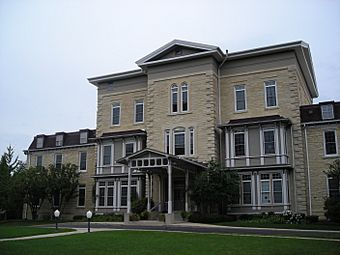Batavia Institute facts for kids
Quick facts for kids |
|
|
Batavia Institute
|
|
 |
|
| Location | Batavia, Kane County, Illinois, United States |
|---|---|
| Built | 1853 |
| Architect | Town, Elijah Shumway |
| Architectural style | Greek Revival |
| NRHP reference No. | 76000712 |
| Added to NRHP | August 13, 1976 |
The Batavia Institute is a special building in Batavia, Illinois, that is listed on the National Register of Historic Places. It has a long and interesting history, changing its purpose many times over the years.
Contents
The Batavia Institute's Story
The Batavia Institute was started as a private school on February 12, 1853. Thirteen men helped create it, including a minister named Rev. Stephen Peet and a doctor named Dennison K. Town.
The main part of the building, which you can still see today at 333 South Jefferson Street in Batavia, was built between 1853 and 1854. It was made from local limestone and cost $20,000. The architect, Elijah Shumway Town, designed it in the Greek Revival style, which looks like ancient Greek temples.
When the Batavia Institute was built, there were no high schools in Batavia. In fact, not many towns had high schools back then. So, students came to the Batavia Institute from all over Illinois to learn. The school was run by local churches for over 10 years. Eventually, new public school laws meant that private schools like this were not needed as much. For a short time, the building was even rented out to the public schools.
A Bid for a Teacher Training School
In 1857, Batavia tried to get a "normal school" for Illinois. A normal school was a special college that trained teachers. Its goal was to set "norms" or standards for teaching, which is how it got its name. Illinois decided to create a normal school on February 18, 1857. It was only the second one west of the Appalachian Mountains.
Cities submitted their offers to the State Board of Education on May 7, 1857. Batavia offered $15,000, plus the land and building of the Batavia Institute, which was worth $30,000. This made their total offer $45,000. Other cities like Washington, Bloomington, and Peoria also made offers. After a lot of discussion, the new university was built in Bloomington. The village where it was built was even renamed Normal in 1865, after the school. Today, that school is Illinois State University.
Bellevue Place: A Rest Home
In 1867, Dr. Richard J. Patterson bought the Batavia Institute building and its land. He turned it into a private rest home and health center for women, which he called Bellevue Place. This center operated until July 1965.
One of the most famous people who stayed there was Mary Todd Lincoln, the wife of U.S. President Abraham Lincoln. She was a patient for several months in the summer of 1875. The building also had a secret passage in the basement. This passage was once part of the Underground Railroad, a network that helped enslaved people escape to freedom.
Fox Hill Home: A Home for Girls
In the 1960s, the building changed again. It became a place called the Fox Hill Home, which supported young women. Later, it became a group home for teenage girls. The Fox Hill Home continued to operate into the late 1970s. By then, the building was in poor condition and needed about $1.5 million in repairs.
Modern Apartments
In the mid-1980s, the building was named Bellevue Place once more. It was then renovated and turned into apartments, which it remains today.
National Register of Historic Places
Because of its long and important history, the Batavia Institute building was officially listed on the National Register of Historic Places on August 13, 1976.

